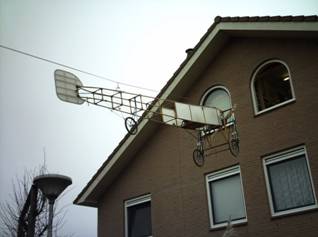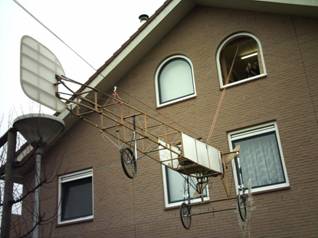The 1:2 scale model
Text: Henk van Hoorn
May 2006 I started to ponder
the building of the present model. I had built the Channelflyer before (see
"the first models") but this time I wanted to build a model that would be
scale-like in every aspect, which meant that adequate
documentation should be available. The choice of the Bleriot XI out of the
series production was therefore a logical one as I had already built the fullsize replica
which was now in Lelystad and I had kept the drawings carefully.
The question arose as to what
size I should build it. Model # 2 was built to a 1:2.2 scale and weighed in at
19 kg (with 2 kg of lead ballast to get the CG right).
Would it be possible to build to half size and still keep the weight under the
25 kg. limit?
Recalculating from the
"real thing" was hardly useful. The empty weight of the plane at Lelystad (a quick
drive there to check it) was 300 kg without pilot. Theoretically that would mean
a weight of 37.5 kg (300 divided by 2 to the third power).
The engine has a weight of 80 kg which would yield 10 kg for the model, but the
engine I had in mind only weighs 5 kg.
Through the abscence of a pilot and by maintaining a lower safetyfactor (according
to the DMFV a factor of 3 is allowed for this kind of models) one could
construct lighter. Added to that the engine has a better performance/weight
ratio.
So back to model #2 for a
comparison. Span goes from 3.9 mtr to 4.5 which is a scale factor of 1.15 and
1.15 to the third power is 1.5 times as heavy. So theoretically: 17 kg (less
lead) times 1.5 ~25 kg.
After extensive weight
calculations of all components in which steel was replaced by duraluminum,
ash-wood by spruce and especially in the tail by abachi, the calculated weight
clearly fell within the 25 kg range.
It was obvious that the te tail be kept as light as possible in order to prevent
the need for lead ballast.
And so the construction could
start.(click the pictures for an enlargement)
 |
Stab and rudder were
constructed first (start small). The core of the rudder is pine wood, the
remaining parts abachi. In the stabilizer and the elevators the steel tube
was replaced by a 6060 T6 dural one, and the control handle which was cast
in aluminum, by a multilayered plywood part (many layers of 2 mm plywood on
top of each other).
Ribs were made
of 3 mm poplar plywood (poplar was used in the real one too)
Likewise the struts and fittings were made out of aluminum and the many
years of Free Flight experience came in handy to enable me to build light
ánd strong.
The spruce main spars and leading edges were hollowed out like the
original and the ribs too were constructed with lightening holes.
|
 |
Next attention turned to the wings.
Not only the measurements but also the construction was carried out to
scale.
Each rib consists of three parts with a top- and bottom strip. In a
special mould the parts were united into one curved unit. Then the ribs
were pushed onto the spars, glued and nailed in place.
The ribs and capstrips are made of 3 mm poplar plywood, the auxiliary
spars of abachi and the main spars of pine wood.
|
 |
The trailing edge and the
laminated tip are made of spruce. The whole construction is quite wobbly and it
should be. Ailerons are nonexistent, lateral control is performed by
warping the wing.
Each winghalf contains 4 groups of 2 fillets on the main spar for
attaching the bracing wires.
|
 |
Autumn 2006 it was the
fuselage's turn. First the 4 pinewood tapered longerons were made to size.
Bending of the wood (in the nose and tail section) was facilitated by
submerging the strips for 10 minutes in a tube filled with ammonia. Then
they were strapped in a somewhat tighter curve than needed, covered in
plastic sheet and left overnight, and lo and behold: you are rewarded with
a curved stringer next morning.
|
 |
All struts are made of
abachi and the framework as a whole is kept together with tensioning bolts
and bracing wires. No glue or screw is used. The upper cabane is
detachable, for it had to leave the attic some day.
The landing gear, tank installation and the controls gave months of building pleasure,
with much work on the lathe and the milling machine.
The wheels are almost completely homebuilt. An oldfashioned pram donated
its rims, spokes and hubs had to be made. Even the tyres were made to
size out of racing bicycle tubes.
The landing gear is sprung and can swivel sideways to compensate for
crosswind landings.
The steering controls are functional. All control surfaces are actuated
either from the rudder bar or the control stick.
|
 |
The engine had been laying
about in the garage for some time and stemmed from an old lawnmower.
Before it was taken out was tested and performed okay.
It's a four-stroke 160 cc. Briggs & Stratton capable of delivering 3.5
hp. After cleaning it was completely dismantled after which anything that
had to do with the forced cooling was removed.
Next the crankcase was reduced in size; the crankshaft was turned off on
the lathe and equipped with ball-bearings. Furthermore a pair of dummy
cylinders was added.
A few lines of text but three months of hard labour.
The propellor was designed to be built by a nearby modelmaker's firm.
|
 |
The covering consists of
lining material; 3 times doped and two layers of varnish added. In totaal
a length of 11 meters was needed. The saleslady enquired:"it's not
for a dress?"
Didn't think so.
In the picture the front part of the fuselage is shown covered... |
 |
... and here the stabilizer. |
 |
A
big plane calls for big servo's.
For the wing and the tail these are GWS colossus with 280 Ncm torque,
mounted under the pilot's chair.
Furthermore there's a double set of batteries (7200 mAh in total) and a
powerboxmanagement system.
|
 |
The gas servo is mounted on the
port side. In front of it the contact breaker is visible and in front of that the
oil pressure gauge.
|


January 2008 everything was ready and the plane was to move house from the
attic to the garage.
It couldn't possibly go down the stairs but thanks to the large windows and the
detachable cabane the fuselage was lifted "over the side" like a
cablecar.











